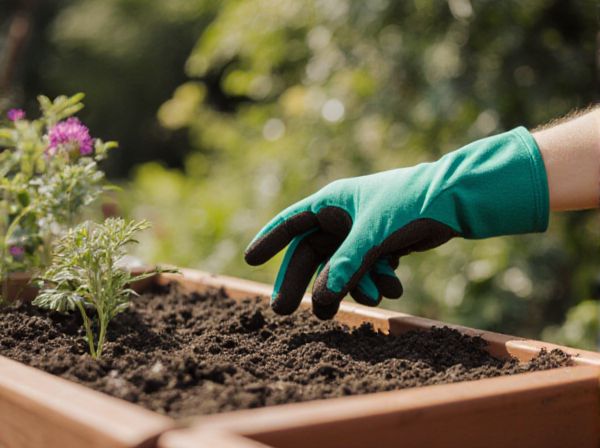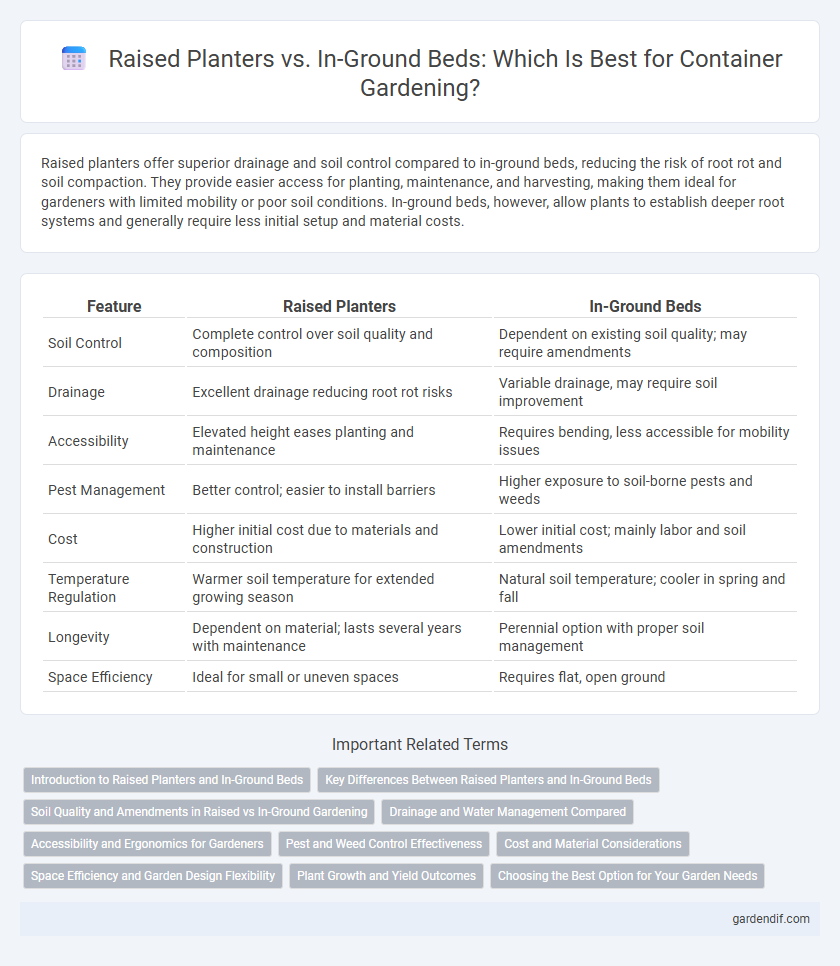
Raised planters vs in-ground beds Illustration
Raised planters offer superior drainage and soil control compared to in-ground beds, reducing the risk of root rot and soil compaction. They provide easier access for planting, maintenance, and harvesting, making them ideal for gardeners with limited mobility or poor soil conditions. In-ground beds, however, allow plants to establish deeper root systems and generally require less initial setup and material costs.
Table of Comparison
| Feature | Raised Planters | In-Ground Beds |
|---|---|---|
| Soil Control | Complete control over soil quality and composition | Dependent on existing soil quality; may require amendments |
| Drainage | Excellent drainage reducing root rot risks | Variable drainage, may require soil improvement |
| Accessibility | Elevated height eases planting and maintenance | Requires bending, less accessible for mobility issues |
| Pest Management | Better control; easier to install barriers | Higher exposure to soil-borne pests and weeds |
| Cost | Higher initial cost due to materials and construction | Lower initial cost; mainly labor and soil amendments |
| Temperature Regulation | Warmer soil temperature for extended growing season | Natural soil temperature; cooler in spring and fall |
| Longevity | Dependent on material; lasts several years with maintenance | Perennial option with proper soil management |
| Space Efficiency | Ideal for small or uneven spaces | Requires flat, open ground |
Introduction to Raised Planters and In-Ground Beds
Raised planters provide improved drainage and soil quality control, making them ideal for growing vegetables and flowers in confined spaces or areas with poor soil. In-ground beds utilize the natural soil structure, supporting deep root growth and larger plants, but may require soil amendment for optimal plant health. Choosing between raised planters and in-ground beds depends on garden space, soil conditions, and plant types.
Key Differences Between Raised Planters and In-Ground Beds
Raised planters offer improved soil drainage, better control over soil quality, and easier access for gardening, making them ideal for urban or compact spaces. In-ground beds naturally blend with existing landscapes and typically require less initial setup but may face challenges with soil compaction and drainage. Both options influence plant growth, pest management, and maintenance, but raised planters provide more flexibility for customization and are often preferred for growing delicate or high-value crops.
Soil Quality and Amendments in Raised vs In-Ground Gardening
Raised planters offer superior control over soil quality by allowing gardeners to customize soil composition and drainage, enhancing nutrient availability and reducing compaction compared to in-ground beds. In-ground gardening depends heavily on native soil characteristics, often requiring substantial amendments like organic matter and pH adjusters to improve fertility and structure. Optimal soil amendments in raised beds include a balanced mix of compost, peat moss, and perlite, promoting aeration and moisture retention that is harder to achieve in natural ground conditions.
Drainage and Water Management Compared
Raised planters offer superior drainage compared to in-ground beds due to their elevated structure and controlled soil composition, reducing waterlogging and root rot risks. In-ground beds rely on natural soil permeability, which can vary widely and often cause poor drainage or excessive moisture retention. Efficient water management in raised planters allows for targeted irrigation and better moisture control, promoting healthier plant growth and minimizing water waste.
Accessibility and Ergonomics for Gardeners
Raised planters offer superior accessibility by elevating the growing surface, reducing the need for bending and kneeling, which benefits gardeners with limited mobility or back issues. In-ground beds require gardeners to bend extensively, potentially causing strain during planting and maintenance tasks. Ergonomically, raised planters can be customized in height and width to accommodate different users, making gardening more comfortable and inclusive.
Pest and Weed Control Effectiveness
Raised planters offer superior pest and weed control effectiveness due to elevated soil levels that reduce the likelihood of soil-borne pests and invasive weeds. In-ground beds are more vulnerable to persistent weeds and subterranean pests, requiring intensive maintenance and chemical interventions. Container gardening in raised planters also allows for better soil management, minimizing pest habitats and facilitating targeted weed control strategies.
Cost and Material Considerations
Raised planters often require durable materials such as cedar, composite wood, or metal, which can increase initial costs but offer long-term durability and reduced maintenance. In-ground beds usually incur lower upfront expenses as they rely on existing soil and minimal structural materials, but may require ongoing soil amendments and edging to maintain shape. Choosing between raised and in-ground options depends on budget constraints, desired longevity, and material sustainability preferences.
Space Efficiency and Garden Design Flexibility
Raised planters optimize space efficiency by allowing vertical stacking and precise soil depth control, maximizing yield in small gardens or urban settings. In-ground beds offer more extensive root expansion and natural soil biodiversity, but require larger horizontal space and are less adaptable to complex garden layouts. Garden design flexibility is enhanced with raised planters due to modular configurations and easier integration with hardscaping elements, supporting diverse aesthetic and functional garden plans.
Plant Growth and Yield Outcomes
Raised planters offer improved soil drainage and aeration, promoting healthier root development and higher nutrient uptake, which often leads to increased plant growth and yield compared to in-ground beds. The controlled soil environment in raised planters reduces soil compaction and pest infiltration, enhancing overall plant vigor and productivity. In contrast, in-ground beds may experience variable soil quality and moisture retention, potentially limiting optimal growth and consistent yields.
Choosing the Best Option for Your Garden Needs
Raised planters offer improved soil drainage, easier access for planting and maintenance, and better control over soil quality, making them ideal for gardeners with limited space or poor soil conditions. In-ground beds provide natural insulation for roots and a larger growing area but require more initial soil preparation and may suffer from drainage issues. Selecting the best option depends on factors such as soil type, garden design, maintenance preferences, and plant species requirements.
Raised planters vs in-ground beds Infographic

 gardendif.com
gardendif.com